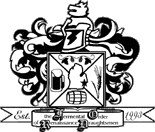 |
 |
 |
 |
 |
 |
| November 2002 | Fermental Order of Renaissance Draughtsmen | Vol. 10 No. 11 |
The December meeting will be held back at Bailey's Pub 'N Grille in Dearborn on Tuesday, December 10. Bailey's is located on the southeast corner of Michigan and Mason. Their address is 22091 Michigan Avenue and their phone number is 313-277-3212. As usual, the thirsty hard-core who want dinner will start arriving around 5PM, people will drift in for an hour or so, and we will start our meeting around 6PM.
The November meeting will be held back at Bailey's Pub 'N Grille in Dearborn on Wednesday, November 13. Bailey's is located on the southeast corner of Michigan and Mason. Their address is 22091 Michigan Avenue and their phone number is 313-277-3212. As usual, the thirsty hard-core who want dinner will start arriving around 5PM, people will drift in for an hour or so, and we will start our meeting around 6PM.
The winners from the Fruit and Spiced Beer Competition are:
| Fruit and Spice Beer Competition | |||
| Place | Name | Style | Points |
| 1 | Kathy Loftus & Doug Geiss | Raspberry Wheat | 46.5/50 |
| 2 | Tyler Barber & Jim Rice | Raspberry Ale | 43.5/50 |
| 3 | John Rucinski | Lime Ale | 37.5/50 |
November's competition will be Non Beer (Wine, Sake, Mead, Cider, etc.). BJCP category 25& 26 , mead and cider are included.
25. MEAD
25A. Traditional Mead
Aroma: Honey aroma should dominate, which may be sweet and may express the aroma of flower nectar. Aromas produced during fermentation, such as fruity esters and alcohol, may also be present.
Appearance: Clarity may be good to brilliant. Carbonated examples will show active evidence of dissolved gas but no head is expected. Color may range from pale straw to deep amber.
Flavor: The flavor of honey should be featured and may include residual sweetness. Any additives, such as acidity or tannin, should enhance the honey flavor and lend balance to the overall character of the mead.
Mouthfeel: Smooth texture. Most will be wine-like, with the warming presence of alcohol and sense of medium body. Sensations of a cloying or astringent character should be avoided.
Comments: A mead made primarily from honey, water and yeast. Meads which feature the character of a blended honey or a blend of honeys. For meads made from a single variety of money see below “B, Varietal Honey Traditional Mead.” While some oxidation of mead is OK and can actually lend useful complexity to the mead, over oxidation as exhibited by sherry-like aroma and/or taste should be avoided. Phenols produced by high temperature fermentation are also to be avoided. Entrants must specify whether the entry is still or sparkling mead. Entrants must also indicate whether the mead is dry, semi-sweet or sweet.
Vital Statistics: Effective OG: 1.070-1.120+
IBUs: N/A FG: 0.995-1.025
SRM: 1-16 ABV: 7.5-15+%
25B. Varietal Honey Traditional Mead
Aroma: Honey aroma should dominate, which may be sweet and may express the aroma of flower nectar. Aromas produced during fermentation, such as fruity esters and alcohol, may also be present. The particular Varietal honey aroma (such as orange blossoms for orange blossom honey) should be evident.
Appearance: Clarity may be good to brilliant. Carbonated examples will show active evidence of dissolved gas but no head is expected. Color may range from pale straw to deep amber.
Flavor: The flavor of honey should be featured and may include residual sweetness. The distinctive taste of the Varietal honey should be showcased. Any additives, such as acidity or tannin, should enhance the honey flavor and lend balance to the overall character of the mead.
Mouthfeel: Smooth texture. Most will be wine-like, with the warming presence of alcohol and sense of medium body. Sensations of a cloying or astringent character should be avoided.
Comments: Mead made from honey from a particular flower source. The brewer must name the varietal honey. Note that the character of a varietal honey will be identifiable as distinct to the source, but may not resemble the source. Orange-blossom honey has the character of orange blossoms, not oranges. Blackberry honey is only distantly like blackberries, although it is an identifiable character. While some oxidation of mead is OK and can actually lend useful complexity to the mead, over oxidation as exhibited by sherry-like aroma and/or taste should be avoided. Phenols produced by high temperature fermentation are also to be avoided. Entrants must specify whether the entry is still or sparkling mead. Entrants must also specify whether the entry is dry, semi-sweet or sweet.
Vital Statistics: Effective OG: 1.070-1.120+
IBUs: N/A FG: 0.995-1.025
SRM: 1-16 ABV: 7.5-15+
25C. Cyser (Apple Melomel)
A mead made with the addition of apples or apple juice. Traditionally, cysers are made by the addition of honey to apple juice without additional water.
Aroma: Should have distinct apple character with a pronounced honey aroma, which may be sweet and may express the aroma of flower nectar. Aromas produced during fermentation, such as fruity esters, low levels of sulfur and alcohol, may also be present.
Appearance: Clarity may be good to brilliant. Carbonated examples will show active evidence of dissolved gas but no head is expected. Color may range from pale straw to deep amber.
Flavor: Should have distinct apple character but should also have a balanced honey character. The Apple character may supply tart acidity to cut the honey sweetness, so one may notice tart acidity first and residual sweetness thereafter. Any additives, such as acidity or tannin, should enhance the honey flavor and lend balance to the overall character of the cyser. In well made examples of the style, the fruit is both distinctive and well-incorporated into the sugar-acid balance of the mead. Some of the best examples have the taste and aroma of an aged Calvados (apple brandy from northern France).
Mouthfeel: Smooth texture. Most will be wine-like, with the warming presence of alcohol and sense of medium body. Sensations of a cloying or astringent character should be avoided.
Comments: There should be an appealing blend of the fruit and honey character but not necessarily an even balance. Generally a good tannin-sweetness balance is desired, though very dry and very sweet examples do exist. Entrants must specify whether the entry is still or sparkling cyser. Entrants must also specify whether the entry is dry, semi-sweet or sweet.
Vital Statistics: Effective OG: 1.070-1.120+
IBUs: N/A FG: 0.995-1.025
SRM: 1-16 ABV: 7.5-15+%
25D. Pyment (Grape Melomel)
A mead made with the addition of grapes or grape juice. Alternatively, the pyment may be a grape wine sweetened with honey, a mixture of grape juice and honey that is fermented or a mixture of grape wine and mead mixed after fermentation.
Aroma: Should have distinct grape or grape-wine character with a pronounced honey aroma, which may be sweet and may express the aroma of flower nectar. Aromas produced during fermentation, such as fruity esters and alcohol, may also be present.
Appearance: Clarity will be good to brilliant. Carbonated examples will show active evidence of dissolved gas but no head is expected. Color would reflect the grape source, whether white, red or other.
Flavor: Should have distinct grape wine character, manifested in acidity, tannin and other grape characteristics, but the honey character should balance the fruit flavors. Grassy white wine character or buttery(diacetyl) Chardonnay character is appropriate in pyment only. In well made examples of the style, the fruit is both distinctive and well-incorporated into the sugar-acid balance of the pyment.
Mouthfeel: Smooth texture. Most will be wine-like, with the warming presence of alcohol and sense of medium body. Sensations of a cloying or astringent character should be avoided.
Comments: There should be an appealing blend of the fruit and honey character but not necessarily an even balance. Generally a good tannin-sweetness balance is desired, though very dry and very sweet examples do exist. Entrants must specify whether the entry is still or sparkling pyment. Entrants must also specify whether the entry is dry, semi-sweet, or sweet.
Vital Statistics: Effective OG: 1.070-1.120+
IBUs: N/A FG: 0.995-1.025
SRM: 1-16 ABV: 7.5-15+%
25E. Other Fruit Melomel
A mead made with the addition of other fruit or fruit juices. There should be an appealing blend of the fruit and honey character but not necessarily an even balance.
Aroma: Should exhibit the aroma of the fruit(s) present in the mead. In a melomel with a blend of fruits, one fruit may dominate the aroma profile.
Appearance: Clarity will be good to brilliant. Carbonated examples will show active evidence of dissolved gas but no head is expected. The particular fruit(s) used may or may not impart color to the mead.
Flavor: Fruit flavor contributions to the mead range from subtle acidic notes to intense, instantly recognizable fruit flavors. In a melomel with a blend of fruits, one fruit may dominate the flavor profile. There should be a balanced honey character as well. Some fruits will lend a cloying sweetness to the mead while others add a drying character. In well- made examples of the style, the fruit is both distinctive and well-incorporated into the sugar-acid balance of the mead.
Mouthfeel: Smooth texture. Most will be wine-like, with the warming presence of alcohol and sense of medium body. Sensations of a cloying or astringent character should be avoided.
Comments: Generally a good tannin-sweetness balance is desired, though very dry and very sweet examples do exist. Some fruits, notably darker ones like Blackberries, may contribute a tannin presence not unlike dark pyments. Some oxidative properties may be appropriate in certain fruit meads, giving them a sherry or port wine character. Entrants must specify whether the entry is still or sparkling mead. Entrants must also specify whether the mead is dry, semi-sweet or sweet.
Vital Statistics: Effective OG: 1.070-1.120+
IBUs: N/A FG: 0.995-1.025
SRM: 1-16 ABV: 7.5-15+%
25F. Metheglin
A mead made with the addition of spices or herbs.
Aroma: The spices/herbs may be expressed in the aroma. Honey characters should appear in the aroma but will vary in intensity depending on the spices/herbs used. Metheglins containing more than one spice should have a good balance among the different spices/herbs, though some spices/herbs will tend to dominate the aroma profile.
Appearance: Clarity may be good to brilliant. Carbonated examples will show active evidence of dissolved gas but no head is expected. Color may range from pale straw to deep amber; the color usually won't be affected by the spices or herbs.
Flavor: The spices/herbs should be expressed in the flavor but the honey character is still the backbone of the mead and should appear in the flavor but will vary in intensity depending on the spices/herbs used. The spices/herbs should be expressed in the flavor as a distinctive enhancement to the honey flavor, whether harmoniously or by contrast, and should achieve a pleasant balance when a blend of spices/herbs is used. Metheglins containing more than one spice should have a good balance among the different spices/herbs, though some spices/herbs will tend to dominate the flavor profile.
Mouthfeel: Smooth texture. Most will be wine-like, with the warming presence of alcohol and sense of medium body. Sensations of a cloying or astringent character should be avoided; however, some spices or herbs may affect mouthfeel particularly by adding astringency.
Comments: Often, a blend of spices may give a character greater than the sum of its parts. The better examples of this style use spices/herbs subtly and when more than one are used, they are carefully selected so that they blend harmoniously. Entrants must specify whether the entry is still or sparkling mead. Entrants must also specify whether the mead is dry, semi-sweet or sweet.
Vital Statistics: Effective OG: 1.070-1.120+
IBUs: N/A FG: 0.995-1.025
SRM: 1-16 ABV: 7.5-15+%
25G. Braggot
Meads made with both honey and malt providing flavor and fermentable extract. Originally, and alternatively, a mixture of mead and ale.
Aroma: Aroma of both honey and malt should be apparent and in balance. Hop aroma may be present but is not required.
Appearance: Straw to dark brown depending on the type of malt and honey used. Some head retention is expected. Clear, although some chill haze may be present at low temperatures.
Flavor: There should be some balance between the beer aspect and the mead aspect of a braggot, especially with regard to maltiness and bitterness versus honey character. Malt character ranges from light pale malt-type flavors to rich caramel flavors, depending on the malt used. Hop bitterness and flavor may be present but are not required.
Mouthfeel: Body may vary from light to medium. Smooth mouthfeel without astringency. Carbonation may vary from light to very lively.
Comments: The fermentable sugars should come from a balance of malt and honey, otherwise the beverage might better be entered as a Specialty Beer with the addition of honey. As a rule of thumb, the fermentables should consist of no less than 1/3 malt and no more than 2/3 honey. Hopped examples of this style should exhibit the hops distinctly and should have at least 15 IBUs.
Vital Statistics Effective OG: 1.060-1.120+
IBUs: 0-50 FG: 1.004-1.025
SRM: 3-16 ABV: 6.5-14%
25H. Mixed Category Mead
A mead that combines ingredients from two or more of the other mead sub-categories.
Aroma, appearance, flavor and other characteristics may vary and be combinations of the respective elements of the various sub-categories used in this style.
Comments: This mead should exhibit the character of all of the ingredients in varying degrees, and should show a good blending or balance between the various flavor elements.
26. CIDER
26A. Standard Cider and Perry
Aroma: Apples (pears, if a perry) should be distinctive and dominate. There may be some fermentation byproducts such as esters, alcohols and low levels of sulfur.
Appearance: Pale yellow to amber in color. Clear and brilliant. Carbonation may vary from absolutely still to very vigorous, as follows, Entrant must specify still or carbonated (level of carbonation optional):
Still: No carbonation visible or in the mouthfeel.
Petillant: Very lightly sparkling, visibly and in the mouth.
Sparkling: Clearly but not heavily carbonated.
Spuming or Spumante: Heavily and vigorously carbonated, bordering on gushing, with tight, fine bubbles, champagne-like.
Flavor: Crisp apple (pear) flavor should be present and distinctive. May be dry to sweet. Some noticeable alcohol character may be present at the upper end of the range (7%). There should be a balance in the acidic character and the residual sweetness.
Mouthfeel: Light body. No astringency. No carbonic bite from CO2.
Comments: Sugar adjuncts may be used. May be fermented by wine, Champagne, ale, lager or wild yeast. The entrant must also specify whether the entry is a cider or perry; dry, semi-dry or sweet; still or carbonated. If both apple and pear juice are used the entry must be entered as a special cider. Artificial carbonation is allowed. The method of carbonation need not be specified.
Vital Statistics: OG: 1.045-1.061
IBUs: NAp; FG: 0.990-1.012
SRM: 3-12 ABV: 4.5-7%
Commercial Examples: Broadoak, Hecks, Dunkerton's, Franklins, Rich's Framhouse Cider (all available only in England), Clos Normand, Herout Fils, Hornsby's Draft Cider (not the “Granny Smith” or “Amber”), Sidra El Gaitero, Kelly's Traditional Irish Premium Hard Cider, Minchew Perry (available only in England), Wyder's Pear Cider.
26B. New England-Style Cider
Aroma: Strong, pronounced apple aroma. The higher level of alcohol,8-14%, will be more noticeable in the aroma. Other fermentation byproducts may also be present.
Appearance: Pale to medium yellow. Still or sparkling. Carbonation must be natural. Clear and brilliant.
Flavor: Strong apple flavor. Usually dry. No hot alcohol taste. New England-Style cider is distinguished from other styles by its robust and sometimes unsophisticated taste. It is a rustic, homemade product, typically more forceful than delicate. Nevertheless, complexity and structure are often present.
Mouthfeel: Medium to full-bodied with some tannins.
Comments: Adjuncts may include white and brown sugars, molasses, honey (very sparingly), and/or raisins. Should use wild or wine yeast only. Entrants must specify whether still or sparkling and whether dry, semi-sweet or sweet.
Vital Statistics: OG: 1.061-1.105
IBUs: N/A FG: 0.990-1.010
SRM: 3-5 ABV: 7-14%
Commercial Examples: There are no known commercial examples of New England-style cider.
26C. Specialty Cider And Perry
Aroma: Apples (pears) should be distinctive and dominate. There may be some fermentation byproducts such as esters, alcohols and low levels of sulfur. Aromas from identified fruits and spices should also be noticeable as well.
Appearance: Carbonation may vary from absolutely still to very vigorous. Pale yellow in color, except where adjuncts such as spices or fruit may introduce a deeper shade or another color. Clear and brilliant.
Flavor: Crisp apple (pear) flavor should be present and distinctive. Declared adjuncts must be present in the taste and integrate well with the base cider. May be dry to sweet. Some noticeable alcohol character may be present but the emphasis should be on alcoholic warming, not the taste or harsh bite of alcohol in the mouth. There should be a balance in the acidic character and the residual sweetness.
Mouthfeel: Light to full body.
Comments: Sugar adjuncts may be used. May be fermented by wine, Champagne, ale, lager or wild yeast. There may be optional ingredients such as fruits and spices in which case the entrant must identify these. The entrant must also specify whether the entry is; dry, semi-dry or sweet; still or carbonated. Artificial carbonation is allowed. The method of carbonation need not be specified. The entrant must be careful in the use of honey as an adjunct; if the honey is the dominant fermentable the entry is a Cyser and must be entered in the Mead competition and not as a cider.
Ingredients: At least 75% apple (pear) juice with the remainder made from any variety of adjuncts. The alcohol content must be below 14%, but any type of yeast can be used in the production.
Vital Statistics: OG: 1.061-1.105
IBUs: N/A FG: 0.990-1.010
SRM: 3-12 ABV: 7-14%
Commercial Examples: Cider Jack fruit ciders.

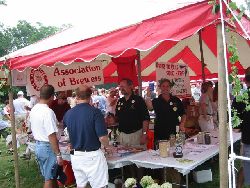 |
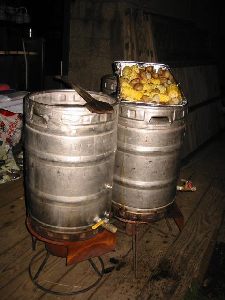 |
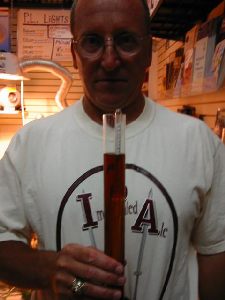 |
 |
 |
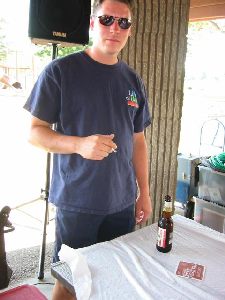 |
 |
 |
 |
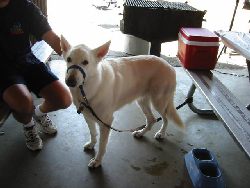 |
 |
 |
So far the nominations are...
Chris Frey for President
Doug Geiss for Treasurer
Kathy Loftus for Vice President
???? for Secretary
Mike Arend for Librarian
Sue Merritt for Mooch (who else could claim it?)
We need nominations at the November meeting for the election in December.
Also, sorry about Dragonmead but I was too late in notifying them about our interest in the Barley Wine unveiling. They would still like us to be there but it will be on Monday, November 11th. If anyone is still interested in going on Saturday, November 16 let me know.
This is a reminder that members of the FORD club are invited to join the Ann Arbor Brewers Guild monthly meeting this coming Friday, November 8th, from 7:00pm on. The AABG club meetings differ from the FORD meetings in some ways. Every monthly meeting is held at a member's home versus a commercial establishment. I had volunteered my home some time ago for the November meeting (BTW - stout is the "featured" style). Also, people are requested to bring an interesting commercial or homebrewed beverage or two, and also to bring a light munchies (something as simple as chips, fresh baked bread, smoked meat, cheese, you get the idea) and your own sampling glass.
For those not familiar with where I live, it is the town of Saline, south of Ann Arbor. One way is I-94 west to the Michigan Ave. exit a little past Willow Run Airport and Ford Lake (is that now called Visteon Lake? ;-) - there will be two Michigan exits, the second one says "Saline". Take that westbound for 6 miles and you will be in downtown Saline. Take a left at Saline Ann Arbor St (south). You won't see any street signs, so look for Mac's & The Brecon Grille restaurants on your left, Dan's Tavern on your right, along with Key Bank. After taking that left you go down the hill, up the hill (maybe 1/4mile) and my house is at the first intersection with a 3-way traffic light. Crestwood will be the right turn, my driveway is the left turn. However, since I share a driveway with my neighbor, please park on the street.
BTW, I will have Ken Schram's Cyser on tap for those who are interested, along with a REALLY BIG Scotch ale.
Here are the minutes for the October 1997 meeting
Rich started the meeting with an introduction of some of our new members. He discussed the legalization rally at Big Buck (details inside) and gave out Hop Posters from the new Zymurgy Hop Edition. He also passed out info on a company that specializes in draft systems and will do custom work as well.
Johanne passed out several ribbons for the recent winners of our most recent competition and collected entries for the Ocktoberfest competition (only one submission! Good luck Jim, but I think you have this one in the bag). She also mentioned that the next local BJCP test is going to be held February 11th, 1998. Contact Johanne Wilson for details.
Tony Truesch volunteered for election monitor for the upcoming elections, but this was later modified to a volunteer to be Vice-President, so we probably need an election monitor - will discuss at next meeting.
We had a special guest speaker - Mr. Patrick Reynolds. Pat is a Leader at Henry Ford Greenfield Village and he is a brewing Historian. He has been working in Museums for 10+ years and as of late can be found providing details of beer history in his talks to visitors.
He started by pointing out that beer has been extremely important to American history. In the 1700's it wasn't safe to drink the water pretty much in any town. Although people didn't understand why their water was unsanitary, unhealthy, etc., they did understand that if you brewed with it and drank the beer, you had a significantly greater chance of surviving.
Beers during this period were usually "small beers", drunk by young and old alike. Their alcohol content probably averaged around 2%. Ginger ale and root beer were not so distant cousins of the style brewed at this time.
And beers were not really brewed so much to style. Rather, fermented beverages were known by their area that they were brewed in. Small beers were rarely fermented through. Instead, they tended to be aged, oh, a week or so and then drunk!
Brewing back then tended to be more of a woman's craft (ergo, the Ale Wife). Women learned from their Mom, and most men didn't want to know and marry a woman whose Mother didn't or couldn't brew.
Pat reiterated the fact that the landing at Plymouth Rock was due to the crew on the Mayflower running out of beer. The first brews in this country were definitely made from malted maize, as there were no native barley plants. Pumpkin Ale was brewed as well as molasses beer, Spruce beer, etc.
Yeast back then was unknown, but they called that stuff on the bottom of the last batch "godisgreat knew enough to pitch the godisgreat into each new batch. Mash Tuns were barrels and brewers knew their Coopers (barrelmakers). In the old days, there was only the single-infusion mash. None of these double decoctions thank you. The thermometer was a finger, which is pretty amazing when you realize the close temps needed to brew beer.
All sorts of neat stuff was utilized before hops plants were imported. Black pepper, hot pepper, sage, heather (reported to have mystical qualities!).
All in all, Pat educated the crowd and amused us when he showed us his mash tun ( an old wooden barrel, basically). If you are at Dearborn Village and you see a man discussing brewing in the olde days, stop and say hi to Pat.
Next month's competition is Holiday Ales, English, Scottish Strong Ale, Barleywines and Imperial Stouts. This includes BJCP Categories 11 & 12. Also, please bring your entries for January 2003. Competition Category (AHA) - Bitter and English Pale Ale - Category 4.
11. ENGLISH AND SCOTTISH STRONG ALE
11A. Old Ale
Aroma: Malty, with complex fruity esters. Some oxidative notes are acceptable, akin to those found in port or sherry. Hop aromas not usually present, due to extended age.
Appearance: Medium amber to very dark red-amber color.
Flavor: Malty and usually sweet, with abundant fruity esters. The nutty malt sweetness yields to a finish that may vary from dry to somewhat sweet. Extended aging may contribute oxidative flavors similar to a fine old port or Madiera wine. Alcoholic strength should be evident, though not overwhelming.
Mouthfeel: Medium to full body; alcohol should contribute some warmth.
Overall Impression: An ale of significant alcoholic strength, though usually not as strong or rich as barleywine. Usually tilted toward a sweeter, more malty balance.
History/Comments: Often regarded as winter warmers, and often released as seasonal beers.
Ingredients: Generous quantities of well-modified pale malt (generally English in origin, though not necessarily so), along with judicious quantities of caramel malts. Some darker examples suggest that dark malts may be appropriate, though sparingly so as to avoid roast character. Adjuncts (such as molasses or dark sugar) may also be utilized. Hop variety is not as important, as the relative balance and aging process negate much of the varietal character.
Vital Statistics: OG: 1.060-1.090+
IBUs: 30-60 FG: 1.015-1.022+
SRM: 12-16 ABV: 6-9+%
Commercial Examples: Theakston Old Peculier, Young's Winter Warmer, Marston Owd Roger.
11B. Strong Scotch Ale (Wee Heavy)
Aroma: Deeply malty, with caramel apparent. Roasty or even smoky secondary aromas may also be present, adding complexity. Moderate diacetyl character is also acceptable.
Appearance: Dark amber to dark brown color, often with ruby highlights.
Flavor: Intensely malty with kettle caramelization apparent. Hint of roasted malt or smoky flavor may be present, as may some buttery diacetyl or nutty character. Hop flavors are low, so malt impression should be dominant.
Mouthfeel: Full-bodied, with a thick, chewy viscosity. Alcoholic warmth should also be present.
Overall Impression: Rich and malty, reminiscent of a dessert. Complex secondary malt flavors prevent a one-dimensional impression.
History/Comments: Fermented at cooler temperatures than most ales, and with lower hopping rates, resulting in clean, intense malt flavors. Well suited to the region of origin, with abundant malt and cool fermentation and aging temperature. Hops, which are not native to Scotland and formerly expensive to import, were kept to a minimum.
Ingredients: Well-modified pale malt, with some crystal and perhaps a dash of darker malt or even roasted barley. A small proportion of smoked malt may add depth, though smoky character may also originate from the yeast. Hop presence is minimal, although English varieties are most authentic. Low-to-medium sulfate and medium carbonate/bicarbonate water is most appropriate.
Vital Statistics: OG: 1.072-1.088+
IBUs: 20-40 FG: 1.019-1.025+
SRM: 10-47 ABV: 6.9-8.5+
Commercial Examples: Traquair House, MacAndrew's Scotch Ale, McEwan's Scotch Ale, Belhaven Wee Heavy, Scotch du Silly, Vermont Pub and Brewery Wee Heavy.
12. BARLEYWINE AND IMPERIAL STOUT
12A. English-style Barleywine
Aroma: Moderate to intense fruitiness; presence of hops (English varieties) may range from mild to assertive. A caramel-like aroma is often present.
Appearance: Color may range from rich gold to very dark amber or even brown. Often has ruby highlights. May have low head retention.
Flavor: Fruity, with a great intensity of malt. Hop bitterness may range from just enough for balance to a firm presence; balance therefore ranges from malty to bitter. Some oxidative flavors may be present, and alcohol should be evident.
Mouthfeel: Full-bodied, with a slick, viscous texture. Gentle smooth warmth from alcohol should be present.
Overall Impression: The richest and strongest of the English Ales.
History/Comments: Usually the strongest ale offered by a brewery, and often vintage-dated. Normally aged significantly prior to release. Often associated with the winter or holiday season. Although a hoppy beer, the English Barleywine places less emphasis on hop character than the American Barleywine and features English hops.
Ingredients: Well-modified pale malt should form the backbone of the grist, with judicious amounts of caramel malts. Dark malts should be used with great restraint, if at all, as most of the color arises from a lengthy boil. English hops such as Northdown, Target, East Kent Goldings and Fuggles.
Vital Statistics: OG: 1.080-1.120+
IBUs: 50-100 FG: 1.020-1.030+
SRM: 10-22 ABV: 8-12+%
Commercial Examples: Anchor Old Foghorn, Young's Old Nick, Fuller's Golden Pride.
12B. American-Style Barleywine
Aroma: Moderate to intense fruitiness; presence of hops (typical American varieties) may range from moderate to dominant. A caramel-like aroma is often present.
Appearance: Color may range from rich gold to very dark amber or even brown. Often has ruby highlights. May have low head retention.
Flavor: Fruity, with a great intensity of malt. Hop bitterness may range from just enough for balance to a firm, resiny dominance; balance therefore ranges from slightly malty to intensely bitter. Some oxidative flavors maybe present, and alcohol should be evident.
Mouthfeel: Full-bodied, with a slick, viscous texture. Gentle smooth warmth from alcohol should be present.
Overall Impression: A well-hopped American interpretation of the richest and strongest of the English ales.
History/Comments: Usually the strongest ale offered by a brewery, and often vintage-dated. Normally aged significantly prior to release. Often associated with the winter or holiday season. The American version of the Barleywine tends to have a greater emphasis on hop bitterness, flavor and aroma than the English Barleywine, featuring American hop varieties.
Ingredients: Well-modified pale malt should form the backbone of the grist, with judicious amounts of caramel malts. Dark malts should be used with great restraint, if at all, as most of the color arises from a lengthy boil. American hops such as Cascades and Centennial.
Vital Statistics: OG: 1.080-1.120+
IBUs: 50-100 FG: 1.020-1.030+
SRM: 10-22 ABV: 8-12+%
Commercial Examples: Sierra Nevada Bigfoot, Rogue Old Crustacean, Victory Old Horizontal.
12C. Russian Imperial Stout
Aroma: Fruity esters, reminiscent of dark fruit, merged with intense roastiness and maltiness. Hop aroma is usually also present.
Appearance: Very dark reddish-black color; opaque.
Flavor: Intensely fruity and malty, backed up by balancing roastiness and prominent hop bitterness and flavor. A "burnt currant" character may be present, along with a suggestion of cocoa or strong coffee. Alcoholic strength should be evident, along with a deep, complex malt flavor. The finish can vary from relatively dry to moderately sweet, usually with some lingering roastiness and warming character.
Mouthfeel: Very full-bodied and rich, with intense flavors and perceptible alcohol presence. Carbonation is relatively low.
Overall Impression: An intensely flavorful beer. Roasty, fruity, and bittersweet, with a notable alcohol presence. Dark fruit melds with roasty, burnt, almost tar-like sensations.
History: Said to be popular with the Russian Imperial Court.
Comments: Brewed to high gravity and hopping level in England for export to the Baltic States and Russia.
Ingredients: Well-modified pale malt, with generous quantities of roasted grain. Flavor and aroma hops should include English varieties for authenticity. Alkaline water would balance the abundance of acidic roasted grain in the grist.
Vital Statistics: OG: 1.075-1.095+
IBUs: 50-90+ FG: 1.018-1.030+
SRM: 20-40 ABV: 8-12+%
Commercial Examples: Samuel Smith Imperial Stout, Courage Imperial Stout, Brooklyn Black Chocolate Stout, Rogue Imperial Stout, North Coast Old Rasputin Imperial Stout, Victory Storm King.
4. BITTER AND ENGLISH PALE ALE
4A. Ordinary Bitter
Aroma: Hop aroma can range from moderate to none. Diacetyl and caramel aromas also moderate to none. Should have mild to moderate fruitiness. The best examples have some malt aroma.
Appearance: Medium gold to medium copper-brown. May have very little head due to low carbonation.
Flavor: Medium to high bitterness. May or may not have hop flavor, diacetyl and fruitiness. Crystal malt flavor very common. Balance varies from even to decidedly bitter, although the bitterness should not completely overpower the malt flavor.
Mouthfeel: Light to medium-light body. Carbonation low, although bottled examples can have moderate carbonation.
Overall Impression: Low gravity, low alcohol levels and low carbonation make this an easy-drinking beer.
History: Originally a draught ale served very fresh under no pressure (gravity or hand pump only) at cellar temperatures. Note that recently some British brewers have been using American hops (e.g., Cascade), but beers made like this fit better into the American pale ale guideline.
Comments: The lightest of the bitters.
Ingredients: Pale ale malt, crystal malts, English hops, often medium sulfate water are used.
Vital Statistics: OG: 1.030-1.038
IBUs: 20-40 FG: 1.008-1.013
SRM: 6-14 ABV: 3-3.8%
Commercial Examples: Henley's Brakspear Bitter, Boddington's Pub Draught, Thomas Hardy Country Bitter, Young's Bitter, Fuller's Chiswick Bitter.
4B. Special or Best Bitter
Aroma: Hop aroma can range from high to none. Diacetyl and caramel aroma moderate to none. Moderate fruitiness. The best examples have some malt aroma.
Appearance: Medium gold to medium copper-brown. May have very little head due to low carbonation.
Flavor: Diacetyl and fruitiness moderate to none. Malt flavor apparent. Medium to high bitterness. Some crystal malt flavor and a moderate amount of hop flavor are common. Balance varies from even to decidedly bitter, although the bitterness should not completely overpower the malt flavor.
Mouthfeel: Medium-light to medium body. Carbonation low, although bottled examples can have moderate carbonation.
Overall Impression: A flavorful, yet refreshing, session beer.
History: Originally a draught ale served very fresh under no pressure (gravity or hand pump only) at cellar temperatures. Note that recently some British brewers have been using American hops (e.g., Cascade), but beers made like this fit better into the American pale ale guideline.
Comments: More evident malt flavor than in an ordinary bitter.
Ingredients: Pale ale malt, crystal malt, English hops, often medium sulfate water is used.
Vital Statistics: OG: 1.039-1.045
IBUs: 20-45 FG: 1.009-1.014
SRM: 6-14 ABV: 3.7-4.8%
Commercial Examples: Young's Ramrod, Fuller's London Pride, Adnam's Suffolk Extra, Timothy Taylor Landlord, Shepherd Neame Masterbrew Bitter, Goose Island Honkers Ale, Spanish Peaks Black Dog Ale, Nor'Wester Best Bitter.
4C. Strong Bitter/English Pale Ale
Aroma: Hop aroma high to none. Diacetyl and caramel aroma moderate to none. Moderate fruitiness. Malt aroma apparent.
Appearance: Copper to dark amber-brown. May have very little head.
Flavor: Malt flavors evident. Crystal malt flavor common. Hop flavor ranges from low to strong. Diacetyl and fruitiness moderate to none. Balance varies from even to quite bitter, although malt flavor should not be completely overpowered.
Mouthfeel: Medium to medium-full body. Carbonation low, although bottled pale ales tend to have moderate carbonation. Warming from alcohol may be noticeable, but should not be strong.
Overall Impression: A solidly flavored beer both in terms of malt and hops.
History: Originally a draught ale served very fresh under no pressure(gravity or hand pump only) at cellar temperatures. Note that recently some British brewers have been using American hops (e.g., Cascade), but beers made like this fit better into the American pale ale guideline.
Comments: More evident malt and hop flavors than in a special or best bitter. English pale ale has long been referred to as "bottled bitter."
Ingredients: Pale ale malt, crystal malt, English hops, often medium sulfate water is used.
Vital Statistics: OG: 1.046-1.065
IBUs: 30-65 FG: 1.011-1.020
SRM: 6-14 ABV: 4.4-6.2%
Commercial Examples: Fullers ESB, Bateman's XXXB, Young's Strong Export Bitter (sold in the US as Young's Special London Ale), Ushers 1824 Particular Ale, Oasis ESB, Big Time ESB, Shepherd Neame Bishop's Finger, Fullers 1845, bottled Bass Ale, Whitbread, Royal Oak, Shepherd Neame Spitfire.
| Beer Events, Meetings & Competitions
Gabrielle Palmer |
 |
| Ye Olde Brew News
published by the F.O.R.D. Homebrew Club |
|
| Editor:
Tony Tantillo Contributors:
Club Officers: |
F.O.R.D. is a private, non-profit organization of homebrewers. The main goal of this club is to
promote awareness and appreciation of the quality and variety of beer; to share information regarding technique, equipment and skill
required to brew quality homemade beer; and to encourage responsible use of beer as an alcohol-containing beverage.
Howard Klix Jr. 24737 Cushing Ave Eastpointe, MI 48021 Phone: (586) 779-1445
Visit our website at: http://www.be.ford.com/brewers/
current circulation... 125 |